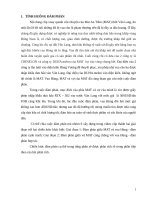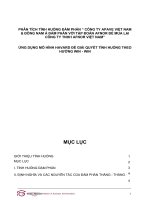PG SUPPLIER CASE tình huống đàm phán
Bạn đang xem bản rút gọn của tài liệu. Xem và tải ngay bản đầy đủ của tài liệu tại đây (199.8 KB, 3 trang )
t
rP
os
9- 6 2 2 - 029
O CTO BER 7, 2021
KRIS FERREIRA
KYM LEW NELSON
CARIN-ISABEL KNOOP
SARAH MEHTA
op
yo
Diversifying P&G’s Supplier Base (B)
After the February 2003 meeting at P&G, Carl Satterwhite, president and co-owner of Infinity
Services, spent the next week pitching partnerships with the five non-minority-owned suppliers he
trusted. Scott Robertson, president and owner of Globe Business Interiors (GBI), was last on his list.
“Because Scott had recently bought out his family, I thought he might be less interested in taking on
another big deal with me. The four other companies I approached unambiguously said no. They
believed that P&G was serious in its push for more inclusive supply chains, but they didn’t see any
way to diversify. They didn’t believe that 1+1 could equal 3.”
tC
But Robertson did see potential, and the two men agreed to meet for breakfast at a restaurant every
Friday morning for several weeks. “At the beginning, we were just calibrating,” said Satterwhite. “It
was, ‘What did P&G say in your room? How did people receive the news?’ But this soon gave way to
discussing how we could bridge the cavernous gap between a white leader of a 40-year-old, familyowned business and a minority-owned company that had started in corporate America and then
transitioned to owning a facilities management business.”
No
For his part, Robertson felt comfortable partnering with Satterwhite. “I came from a background
that taught me to embrace diversity,” he said. “I spent time within the minority community and had
developed many strong personal and professional relationships.” Added Satterwhite, “Scott was a
white leader in this community who walked in rooms with people of color. It wasn’t a new
conversation for him.” He contrasted Robertson’s orientation to some of his non-minority-owned
peers. “For many, it was a matter of checking the diversity box when they were responding to an RFP,”
he said. “They would find an MBE to unpack boxes or unload trucks, but negotiating at an ownership
level was often out of the question. Scott embraced the true meaning of diversity.”
Structuring a Deal
Do
Once the two men agreed that it would be mutually beneficial for them to partner, they began to
consider how to structure a deal. To secure MBE certification, Satterwhite would need to own at least
51% of any joint venture they created. After considerable discussion, Satterwhite and Robertson
Professor Kris Ferreira, Senior Lecturer Kym Lew Nelson, and Executive Director Carin-Isabel Knoop and Case Researcher Sarah Mehta (both of
Case Research and Writing Group) prepared this case. It was reviewed and approved before publication by a company designate. Funding for the
development of this case was provided by Harvard Business School and not by the company. HBS cases are developed solely as the basis for class
discussion. Cases are not intended to serve as endorsements, sources of primary data, or illustrations of effective or ineffective management.
Copyright © 2021 President and Fellows of Harvard College. To order copies or request permission to reproduce materials, call 1-800-545-7685,
write Harvard Business School Publishing, Boston, MA 02163, or go to www.hbsp.harvard.edu. This publication may not be digitized, photocopied,
or otherwise reproduced, posted, or transmitted, without the permission of Harvard Business School.
This document is authorized for educator review use only by NGO XUAN BINH, Banking University of Ho Chi Minh City until Mar 2023. Copying or posting is an infringement of copyright.
or 617.783.7860
Diversifying P&G’s Supplier Base (B)
rP
os
t
622-029
decided to make the ownership split 55/45 instead of 51/49. “It just felt better to both of us not to split
hairs and to be truly minority-owned,” said Robertson.
They asked attorneys George Vincent and Calvin Buford for legal advice. Vincent was a friend of
Robertson and legal counsel for P&G. Buford was a friend of Satterwhite and legal counsel for the local
NMSDC certifying council. “Because he held that latter role,” said Satterwhite, “whatever sausage had
to be made for our joint venture to be MBE certifiable, Calvin was the king. He would make sure that
we didn’t end up as a front and that our paperwork was complete.” Given their roles, these two men
were uniquely qualified to advise Satterwhite and Robertson on their joint venture.
op
yo
Buford explained that to be a certified MBE at scale, Satterwhite and Robertson needed to prove
three things: care, custody, and business control. “My background could prove care and custody,” said
Satterwhite. “What we needed to prove was control. Scott needed to allow my wife and me to buy 55%
of the business he’d already built. He had to digest that.” For Robertson, the math was simple. “At the
end of the day,” he said, “Carl had to believe that 55% of a bigger pie was worth more than 100% of
Infinity’s pie. And I had to believe that 45% of a bigger pie was worth more than my 100% of GBI. I
fully believed this. I knew that a joint venture would present growth opportunities.”
The terms of their deal gave Satterwhite seven years to buy Robertson’s share of the business.
Satterwhite could use proceeds from growth to pay Robertson. “But,” said Satterwhite, “if we didn’t
grow, I fully bore the risk. It was possible that I would buy 55% of the business and pay more than the
market would bear only for us to go under.” The deal’s structure guaranteed that Robertson would
recoup 55% of the value of his business in 2003 terms. “But Scott bore the risk of relinquishing control
of GBI only to get back a potentially fatally wounded business,” said Satterwhite. Added Robertson:
tC
There was no guarantee of business just because we were a certified MBE. We knew
we also had to be best-in-class. With clients, we didn’t lead with our MBE status. We led
with the fact that we were an excellent company that happened to be minority-owned.
We understood that P&G’s desire to have inclusion in the supply chain was not a social
program. It was an economic program. They said, “We don’t sell to only white people; we
sell to everyone. So we want our supply chain to look like our customers.” For Carl and I,
that was the best language used for this, and we’ve seen the impact. What Procter has
done to advance inclusion. There’s no second place. They’re pushing the marketplace.
No
Robertson and Satterwhite agreed to the terms and launched a joint venture called River City
Furniture (RCF) in autumn 2003. With Buford’s help, RCF became MBE certified that same year.
Do
Robertson noted that the fact that RCF already had a book of established accounts upon creation
immensely helped to ease the pressure. “At the time, we had P&G, Cinergy (now Duke Energy), and
Kroger, among others. It would be hard for any person to just start a furniture dealership from scratch,
so that helped.” Robertson also believed that his and Satterwhite’s personalities and work styles were
complementary: “He allows me to be who I am, and I allow him to be who he is. You wouldn’t want
two of me in a room, and you wouldn’t want two of Carl in a room. It’s the combination that allows us
to work well together.”
But even with their existing accounts and complementary styles, the transition from GBI to RCF
was not without difficulty. A few months after launching RCF, a supplier requested a down payment
on a purchase. “This is a company that GBI had been buying from for 25 years,” said Robertson, “and
suddenly they want a down payment. We asked why and they said, ‘Well, you’re a minority-owned
company now.’ I was shocked and angry. Several things like that happened that I just couldn’t believe.”
2
This document is authorized for educator review use only by NGO XUAN BINH, Banking University of Ho Chi Minh City until Mar 2023. Copying or posting is an infringement of copyright.
or 617.783.7860
622-029
rP
os
t
Diversifying P&G’s Supplier Base (B)
In addition, Satterwhite felt pressure to ensure that RCF benefitted not only him and his wife but
also the broader community. At the time, not a single person of color worked at GBI. “It’s not that there
was any overt racism,” said Satterwhite, “but there were strong biases at play.” He knew that RCF
would need to be an intentionally inclusive workplace. As he recalled:
Early on, I received a call from the NMSDC CEO. Their review of RCF’s paperwork
had made it to the national level. She said, “If, in 15 years, this company is successful and
has grown, and Scott is richer, and you and your wife are richer, but you haven’t impacted
the community, you haven’t hired people of color, you haven’t taken what you’ve learned
and helped the broader community, I will come back and hunt you down.”
op
yo
Performance
The men were determined to succeed. “Failure was not part of our vocabulary,” said Robertson.
“By the sheer force of our will, Carl and I would make RCF successful.” Their efforts paid off. The
company exceeded its revenue goals in its first 12 months and doubled revenue in year two.
In 2004, RCF was rebranded as RCF Group as the company grew into more than an office furniture
dealership by launching an asset management division. They continued to expand into other verticals,
adding a move management division in 2005 and a landscape management division in 2006.
Within seven years, Satterwhite completed buying out 55% of the company from Robertson. By
2008, RCF Group was reporting roughly $35 million in annual revenues. Satterwhite’s ambitions for
RCF Group were broad. “Our goal was to eventually do $100 million in revenue,” he said. “We knew
that if we focused on the broader North America marketplace, we could achieve our goals.”
Do
No
tC
RCF Group was also deeply involved in the Cincinnati community and had made strides in
inclusive hiring. Over time, the proportion of employees of color at RCF increased from 1% to 10%.
Satterwhite and Robertson continued to build on that, both internally (in hiring) and externally (in
purchasing from other minority-owned suppliers). Robertson remarked on the value of diversity at
RCF Group: “We’re now entering the marketplace looking and thinking differently. We are better
because we are diverse. We really are. We think differently together.”
3
This document is authorized for educator review use only by NGO XUAN BINH, Banking University of Ho Chi Minh City until Mar 2023. Copying or posting is an infringement of copyright.
or 617.783.7860









